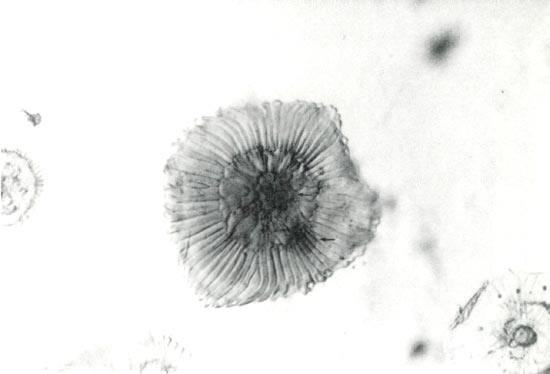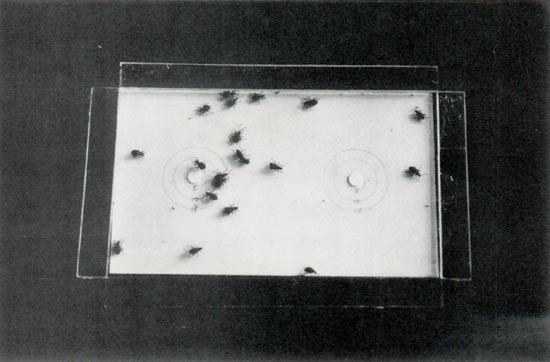JARS v41n2 - Essential Oils And Rhododendron Scales
Essential Oils And Rhododendron Scales
Robert P. Doss, Ph.D.
U.S. Department of Agriculture
Agricultural Research Service and Department of Horticulture
Oregon State University, Corvallis, Oregon
Rhododendron fanciers are familiar with the scales borne on the leaves of the lepidote rhododendrons. Scale morphology serves as an important character in classifying the lepidote species. What may be less well-known is that the scales are rich sources of essential oils 1 (Figure 1). In fact, it is the scale-borne essential oils that impart the odor to leaves of certain lepidote species.

|
|
Figure 1. A detached scale (about 0.3 mm in diameter) from
R. chryseum showing oil droplets (arrows). Taken, with permission, from J. Chem. Ecol. 10:1787 (1984). |
The volatile compounds in rhododendron scales are responsible for the resistance to adult root weevil feeding exhibited by some lepidote plants (Figure 2). The most resistant species are those with leaves containing the largest amounts of such materials.

|
|
Figure 2. Obscure root weevils are repelled by germacrone,
a material in the essential oil from R. edgeworthii , that has been applied (0.05 mg) to the filter paper disk on the right. |
The amounts of essential oils present in the leaves are determined by the density of scales and the amount of oil present in each scale. Scale density, in one group of 11 species varied from 109 scales per square centimeter on R. rigidum , which has scales only on the lower surface, to 4189 scales per square centimeter on R. chryseum , which has scales on both surfaces. Essential oil contents in this same group varied from 25 mg/scale with R. lepidotum to 151 mg/scale with R. edgeworthii .
Just as scales from different species vary in morphology, they also vary with respect to the chemical compounds making up the essential oils (Table 1). The oils are often very complex, some containing 20 compounds at fairly high concentration, and many more compounds at lower concentration. Many of the materials detected have not been identified. The materials listed in Table 1 are monoterpenes and sesquiterpenes 2 , compounds found in rhododendron essential oils.
|
Table 1. Components Present In Essential Oils from 43 Lepidote Rhododendron Species
Taken with permission from Phytochemistry, 1986 |
||||||||||||||||||
|
Species
Clone Subsection |
Total
peaks |
cam-
phene |
α-
pinene |
ß-
pinene |
ß-
myr- cene |
1,8
cin- eole |
lina-
lool |
α-
terpi- neal |
gera-
niol |
caryo-phyl-lene |
α-
humu- lene |
cis
nero- lidol |
trans
nero- lidol |
β-
eleme-none |
γ-eudes-mol |
α/ß-
eudes-mol |
ger-ma-crone |
farnesol
isomers |
|
edgeworthii Hooker
65.383 Edgeworthia |
18 | 02 | 01 | 10 | 01 | 03 | 26 1 | 01 | ||||||||||
|
ciliatum Hooker
65.352 Maddenia |
12 | 28 | 05 | 03 | 45 1 | |||||||||||||
|
moupinense Franchet
74.83 Moupinensia |
09 | 15 | 10 | |||||||||||||||
|
hanceanum Hemsley
76.34 Tephropepla |
03 | 39 | ||||||||||||||||
|
tatsienense Franchet
70.422 Triflora |
06 | 68 1 | 20 | 06 | 04 | |||||||||||||
|
rigidum Franchet
73.353 Triflora |
07 | |||||||||||||||||
|
keiskei Miquel
76.40 Triflora |
13 | 30 | 09 | 06 | 04 | 07 | 01 | |||||||||||
|
concinnum Hemsley
73.70 Triflora |
17 | 06 | 27 1 | 02 | 01 | 03 | ||||||||||||
|
lutescens Franchet
70.107 Triflora |
12 | 04 | 06 | 09 | 03 | 05 | 02 | |||||||||||
|
bauhiniiflorum Hutch.
2
73.26 Triflora |
10 | 20 1 | 05 | 13 | 06 | 18 | ||||||||||||
|
trichanthum Rehder
73.280 Triflora |
07 | 06 | 15 | 62 1 | 01 | |||||||||||||
|
augustinii Hemsley
77.207 Triflora |
18 | 16 1 | 03 | 08 | ||||||||||||||
|
triflorum
Hooker
70.26 Triflora |
13 | 08 | 18 | |||||||||||||||
|
zaleucum
Balf. f. & W.W. Sm. 65.405 Triflora |
13 | 13 | 40 1 | 24 | 01 | 01 | 01 | |||||||||||
|
davidsonianum
Rehd. & Wilson
66.600 Triflora |
08 | 35 1 | 23 | 08 | 06 | |||||||||||||
|
yunnanense
Franchet 70.333
Triflora |
11 | 34 1 | 02 | |||||||||||||||
|
scabrifolium Franchet
70.155
Scabrifolia |
03 | 90 1 | 01 | 10 | ||||||||||||||
|
rubiginosum Franchet
73.130
Heliolepida |
15 | 14 | ||||||||||||||||
|
carolinianum Rehder
75.133 Caroliniana |
09 | 10 | 30 | 01 | 07 | 46 1 | 01 | |||||||||||
|
dauricum
L. 66.590
|
11 | 02 | 01 | 09 | 06 | 11 | 49 1 | |||||||||||
|
chryseum
Balf. f. & Ward
3
75.28 Lapponica |
17 | 19 | 09 | 14 | 02 | 03 | ||||||||||||
|
hippophaeoides
Balf. f. & Ward 73.135
Lapponica |
20 | 09 | 04 | 18 | 17 | 18 | 19 | 39 1 | 07 | |||||||||
|
paludosum
Hutch.
4
65.457
Lapponica |
09 | 03 | 07 | 01 | 07 | |||||||||||||
|
cuneatum
Sm.
65.497 Lapponica |
14 | 30 1 | 17 | |||||||||||||||
|
polycladum
Franchet
65.459 Lapponica |
16 | 02 | 08 | 11 | 09 | 01 | ||||||||||||
|
nivale
Hooker
76.300 Lapponica |
16 | 03 | 05 | 05 | 08 | 07 | 13 | 03 | ||||||||||
|
russatum
Balf. f. & Forr.
73.24 Lapponica |
17 | 20 1 | 06 | 15 | ||||||||||||||
|
impeditum
Balf. f. & W.W. Sm.
76.102 Lapponica |
18 | 11 | 03 | 04 | 01 | 08 | 07 | 17 1 | 14 | 05 | 06 | 11 | 02 | |||||
|
dasypetalum
Balf. f. & Forr. 74.70
Lapponica |
12 | 06 | 04 | 02 | 14 | 02 | ||||||||||||
|
intricatum
Franchet
73.144 Lapponica |
08 | 06 | 03 | 25 | ||||||||||||||
|
capitatum
Maxim.
74.64 Lapponica |
09 | 32 | 47 1 | 02 | ||||||||||||||
|
ferrugineum
L
76.381 Rhododendron |
18 | 20 | 15 | 01 | ||||||||||||||
|
micranthum
Turcz 76.399 Micrantha |
09 | 16 | 03 | 09 | ||||||||||||||
|
calostrotum
Balf. f. & Ward
66.573 Saluenensia |
20 | 02 | 11 | 07 | 08 | 04 | 07 | 09 | 08 | 05 | ||||||||
|
pemakocnse
Ward
70.42 Uniflora |
10 | 06 | 09 | |||||||||||||||
|
xanthocodon
Hutch.
5
73.305 Cinnabarina |
18 | 10 | 07 | 03 | ||||||||||||||
|
virgatum
Hooker
65.404 Virgata |
11 | 38 | 02 | 03 | 09 | 08 | 10 | 12 | ||||||||||
|
glaucophyllum
Rehder
76.98 Glauca |
16 | 20 | 04 | 07 | ||||||||||||||
|
glaucophyllum
var.
luteiflorum
Rehder
6
64.114
Glauca |
12 | 03 | 09 | 06 | 04 | 05 | 02 | 05 | 28 1 | |||||||||
|
campylogynum
Franchet
74.62 Camphylogyna |
12 | 08 | 05 | 03 | 60 1 | 02 | ||||||||||||
|
lepidotum
Wallich
79.53 Lepidota |
13 | 50 | 22 | 01 | 03 | |||||||||||||
|
baileyi
Balf
64.146 Baileya |
13 | 12 | 09 | 02 | ||||||||||||||
|
leucaspis
Tagg
65.398 Boothia |
03 | |||||||||||||||||
|
rubrolineatum
Balf. f. & Forr.
7
76.205 Trichoclada |
08 | 19 | 14 | 18 | 04 | |||||||||||||
|
1
Largest peak in extract.
2 R. bauhiniiflorum is considered a variety of R. triflorum Hooker by some authors. 3 R. chryseum is considered a variety of R. rupicola W.W. Sm. by some authors. 4 R paludosum is considered to be the same as R. nivale Hooker, subspecies nivale by some authors. 5 R. xanthocodon is considered a subspecies of R. cinnabarinum by some authors. 6 R. glaucophyllum var. luteiflorum is considered to be R. luteiflorum Cullen by some authors. 7 R. rubrolineatum is considered a variety of R. mekongense Franchet by some authors. |
||||||||||||||||||
Clone numbers referred to in Table 1 are Rhododendron Species Foundation numbers. The peak numbers shown on the Table are estimates of the percentage composition of the particular oil present in the sample.
The materials shown in Table 1, with a few exceptions, are common constituents of essential oils of other plants. For example, humulene and caryophyllene are found in hops, the eudesmols are found in eucalyptus, and the pinenes are found in leaves of many plant species. The complexity and variation of the essential oils of different rhododendron species suggest that, like scale morphology, oil composition could be used in classification.
Before the usefulness of essential oil profiles can be tested, it will be necessary to identify more of the compounds making up the oils, including materials found at only trace levels. With such information it may be possible to improve the taxonomic treatment of the lepidote rhododendrons.

|
Acknowledgements: Some of the information in this report was obtained with support from the American Rhododendron Society Research Foundation. Contribution of the Agricultural Research Service, U.S. Department of Agriculture, in cooperation with the Agriculture Experiment Station, Oregon State University. Technical Paper No. 7938 of the latter.
1
Essential oils are volatile oils found in plants that often possess a strong odor. These volatile oils are frequently a mixture of many compounds.
2
Monoterpenes and sesquiterpenes are compounds containing 10 and 15 carbon atoms, respectively, and are formed from 5 carbon atom units (isoprene units) via the terpenoid biosynthetic pathway, an important biosynthetic pathway in plants.
References:
Doss, R.P., R. Luthi, and B.F. Hrutfiord. 1980. Cermacrone, a sesquiterpene repellent to obscure root weevil from
Rhododendron edgeworthii
.
Phytochemistry
19:2379-2380.
Doss, R.P. 1984. Role of glandular scales of lepidote rhododendrons in insect resistance.
J. Chem. Ecol.
10:1787-1798.
Doss, R.P., W.H. Hatheway, and B.F. Hrutfiord. 1986. Composition of essential oils of some lepidote
Rhododendrons
.
Phytochemistry
25:1637-1640.
Dr. Doss is plant physiologist at the Horticultural Crops Research Laboratory, Corvallis, Oregon, specializing in the physiology of flowering and plant defenses.
